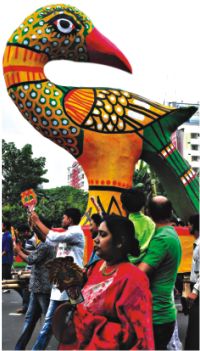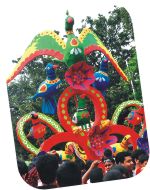Colours of a new year
By Rannia Shehrish
Photo: Adnan M S Fakir
One of the most famous events on Pohela Boishakh is the Mongol Shobha Jatra - a rally led by the students and faculty members of Charukola every year. An integral part of the celebrations, the rally is the centrepiece of the riot of colours that accompanies Bangla New Year. Being curious, we went to Charukola hoping to dig out some news on the making of the sculptures and masks that are used in the rally.
 The rain had stopped a little before our arrival at the institute. The soil was muddy and the presence of the dark clouds announced the imminent arrival of another shower. The drizzle left a misty chill hanging in the air. Amidst that damp setting, excitement and passion were simultaneously working with hard work and determination to successfully complete the ornaments for the upcoming Mongol Shobha Jatra.
The rain had stopped a little before our arrival at the institute. The soil was muddy and the presence of the dark clouds announced the imminent arrival of another shower. The drizzle left a misty chill hanging in the air. Amidst that damp setting, excitement and passion were simultaneously working with hard work and determination to successfully complete the ornaments for the upcoming Mongol Shobha Jatra.
Beautiful paintings and brightly coloured masks and shoras greeted us. Talking around, we discovered that every year the senior most students (Honours, final year - 11th batch this year) are in charge of the whole programme from the finance to the making of the sculptures. They are collectively known as the Boishakh Udjapon Committee. Pintu, a member of the committee, informed us about their plans for this year's Mongol Shobha Jatra. “The theme we are working on is not finalised yet but like the previous year - along with all the positives, we want to symbolise the presence of the negative too.' The work hours are usually a day long and, at times, may extend till the night. The work began on the 21st of March and will continue till the last day of the Bengali year.
A fair is held at the Charukola premises to raise money for the rally, where the works of the students, teachers and other senior artists are sold, from the 21st of March till the 14th of April. The starting funds are from last year's surplus. The crafts sold comprise of paper cut masks, papier-mâché masks, shora chitro, small earthen and ceramic sculptures and the artworks include water colours, pencil sketches, etc. The prices of each painting starts from 300 and the cost of crafts vary with their sizes and design complexities.
 The yard was full of students busy at work, despite the poor weather. 'The sculptures are usually based on folk motifs and also to represent current events,' Manobendro, a student of 12th batch told us while working on one of the frames, 'The teachers along with the committee decide on which sculptures to make.' This year there will be a tiger, two ponies, a composition of three birds, an elephant, a shampaan which will symbolise shomudro bijoy and another composition representing negative forces against Mukti Juddho and our sovereignty. After the rally the sculptures are used to adorn the campus.
The yard was full of students busy at work, despite the poor weather. 'The sculptures are usually based on folk motifs and also to represent current events,' Manobendro, a student of 12th batch told us while working on one of the frames, 'The teachers along with the committee decide on which sculptures to make.' This year there will be a tiger, two ponies, a composition of three birds, an elephant, a shampaan which will symbolise shomudro bijoy and another composition representing negative forces against Mukti Juddho and our sovereignty. After the rally the sculptures are used to adorn the campus.
The masks were being prepared in the rooms inside. There were two types of masks - the papier-mâché ones and the paper cut ones. About 1000 of the paper cut masks were to be made. These masks are designed to look like owls, rabbits, monkeys and tigers. When asked about the papier-mâché masks, Anwar, a junior, told us that about 13 could be made in a day. This time the faces of kings, queens and giants were being highlighted. In a corner near the stalls, a group of students were busy painting and decorating the smaller ornaments - the shoras of different sizes and shapes, small paper masks and pakhas (hand-fan). Their target is to make 500 of each item but it usually varies with the demand.
When we asked the students about their feelings regarding all the labour, we were answered with broad smiles and shining faces. 'We wait eagerly for this all year and when it finally arrives we can't wait to start working. We enjoy this very much,' said Lina. The whole campus was in high-spirits and enthusiasm hung in the atmosphere. The students' and teachers' uphill struggle to make another borsho boron uthshob memorable truly pays off at the end when the bright and vivacious Mongol Shobha Jatra embellishes the streets of Dhaka.
Food for thought or thought for food
By Mastura Tasnim
Everyone wants to be happy. Everyone also likes to think about the meaning of life, the universe and what to have for lunch while stuck in traffic. Unfortunately, there are already people who have been there, done that and become famous for it.
The Greeks alone have three schools of thought which developed during the Hellenistic Period (we're guessing that's the time when people were busy thinking about Helen of Troy - that girl was da bomb, or so we hear).
 As bad as the name sounds, Cynics of that era were actually just people who gave up on material luxury, political power and good health for happiness. Yes, they gave up on money, world domination and white teeth all in one go. They were like hippies in that way, except they didn't even fight for their rights because they thought they didn't need them either.
As bad as the name sounds, Cynics of that era were actually just people who gave up on material luxury, political power and good health for happiness. Yes, they gave up on money, world domination and white teeth all in one go. They were like hippies in that way, except they didn't even fight for their rights because they thought they didn't need them either.
One particularly hardcore Cynic, called Diogenes, lived in a barrel and owned nothing except a cloak, a stick and a bread bag. It is said that Alexander the Great came to visit him once while he was sunbathing beside his barrel. The emperor must have been in a good mood because he asked Diogenes if he could do anything for him, to which the Cynic promptly replied, “Yeah, sure. Stand to one side, you're blocking the sun.” Other than making Cynicism popular, we're pretty sure he got hailed for being badass before it was cool.
The Stoics, true to their name, were a class of people who didn't let their feelings get in the way of feeling happy. Though we don't really understand how that works, we were impressed with their Batman-like ideas of absolute truth and justice and the need to implement both in society despite personal hardships. We also like Cicero (a stoic) because he introduced the idea of life with the individual at the central, and, you know, everyone loves to think the world revolves around them.
While the Cynics and the Stoics were busy being serious about being happy, the Epicureans decided to just do whatever made them happy. They said 'pleasure is the highest good' and invited people to their gardens to take part in said pleasure. We're imagining a lot of guys in togas chilling out amongst the flowerbeds.
Nowadays, the word 'epicurean' is used to describe people like Homer, who live only for the pleasure of food, Marge and more food.
Then some guys went all Inception in the 18th century and started arguing about whether we could trust our senses or logic since we might as well be dreaming.
Hume shows up and tells us we can only sense a portion of the world, and so we can't be completely sure of anything through logic, not even whether or not the moon is just a humungous mound of cheese. This idea makes us very happy because there can never be enough cheese in the world. And never enough cheesecake either.
Kant said, and we paraphrase here, “Oh hell, no! Just because we haven't seen something doesn't mean it doesn't exist somewhere out there.” Our sources say he was most probably the inspiration behind Luna Lovegood's father.
Of course, all the other guys look silly when you think absurdly. The absurd think that the universe has better things to do than care about us and we could never understand it, with logic or senses. Replace the absurd with a heart-broken teenager and the universe with a cruel girl, and there you have our modern-day emo.
Just goes to show that Greeks were so much cooler, with their garden hang-outs and badasserry.
Fumes
The incense burnt its way into the night
The frail fumes breathing, conjuring, bathing
odours of pomegranate that casually seeped
into your charcoal stained eyes.
Your eyes that smiled and talked,
Eyes that chattered from the edges of your dark kohl,
of kohl that danced with the smiles of your lustrous eyes.
They chattered bliss and woe, of life ensued
and smuggled my breaths into gallant fumes;
The fumes took forms the burnt incense never dared
Forms of dreams to behold the smiles of your eyes,
forms drawn to your calluses, whims and rhetoric;
forms that became a conjurer of a fable
a fable left hidden in the smiles of your charcoal stained eyes.
By Adnan M. S. Fakir

